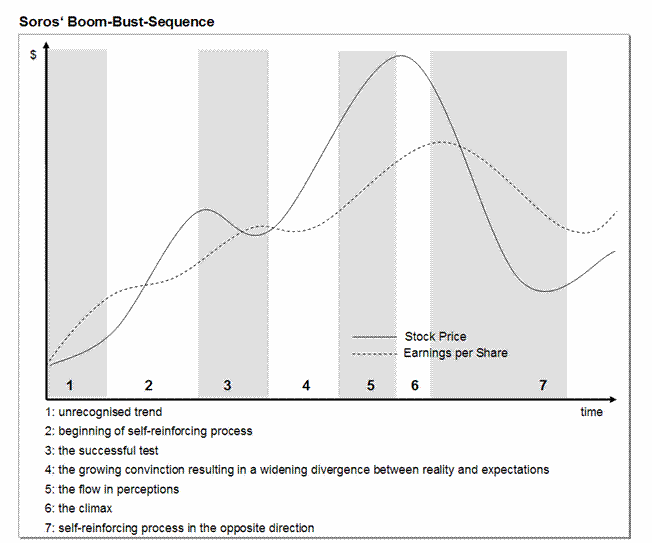Soros' Boom-Burst-Sequence
I'd like to publish now the Boom-Burst-Sequence of stock markets I have once read about in George Soros books and interviews. It is an interesting pattern to look at the development on the bourses.
So I have once copied a graphic from his book "The Alchemy of Finance" and now tried to draw it again. Here is the outcome and the phases model of the self-reinforcing process which Soros considers most essencial for the stock markets:

Here is the way George Soros introduces and describes the logic behind the picture:
First, we must start with some definitions. When stock prices reinforce the underlying trend, we shall call the trend self-reinforcing; when they work in the opposite direction, self correcting. The same terminology holds for the prevailing bias: it can be self-reinforcing or self-correcting. It is important to realize what these terms mean. When a trend is reinforced, it accelerates. When the bias is reinforced, the divergence between expectations and the actual course of future stock prices gets wider and, conversely, when it is self correcting, the divergence gets narrower. As far as stock prices are concerned, we shall describe them simply as rising and falling. When the prevailing bias helps to raise prices, we shall call it positive; when it works in the opposite direction, negative. Thus rising prices are reinforced by a positive bias and falling prices by a negative one. In a boom/bust sequence, we would expect to find at least one stretch where rising prices are reinforced by a positive bias and another where falling prices are reinforced by a negative bias. There must also be a point where the underlying trend and the prevailing bias combine to reverse the trend in stock prices.
Let us now try to build a rudimentary model of boom and bust. We start with an underlying trend that is not yet recognized - although a prevailing bias that is not yet reflected in stock prices is also conceivable. Thus, the prevailing bias is negative to start with. When the market participants recognize the trend, this change in perceptions will affect stock prices. The change in stock prices may or may not affect the underlying trend. In the latter case, there is little more to discuss. In the former case, we have the beginning of a self-reinforcing process.
The enhanced trend will affect the prevailing bias in one or two ways: it will lead to the expectation of further acceleration or to the expectation of a correction. In the latter case, the underlying trend may or may not survive the correction in stock prices. In the former case, a positive bias develops causing a further rise in stock prices and a further acceleration in the underlying trend. As long as the bias of self-reinforcing, expectations rise even faster than stock prices. The underlying trend becomes increasingly influenced by stock prices and the rise in stock prices becomes increasingly dependent on the prevailing bias, so that both the underlying trend and the prevailing bias becomes increasingly vulnerable. Eventually, the trend in prices cannot sustain prevailing expectations and a correction sets in. Disappointed expectations have a negative effect on stock prices, and faltering stock prices weaken the underlying trend. If the underlying trend has become overly dependent on stock prices, the correction may turn into a total reversal. In that case, stock prices fall, the underlying trend is reversed, the expectations fall even further. In this way, a self reinforcing process gets started in the opposite direction. Eventually, the downturn also reaches a climax and a reverse itself.
And where do we stand now?... All opinions are welcomed...
stocks bourse soros
Disclaimer - I do not make recommendations to buy or sell securities - I just post my thoughts, trades and opinions. Please read the disclaimer text at the bottom of the site




0 Comments:
Post a Comment
<< Home